I am entertaining myself with a list of critics and artists who will hate “©Murakami,” a retrospective of the Japanese artist Takashi Murakami (b. 1962), at the Brooklyn Museum (200 Eastern Parkway) to July 13, 2008.
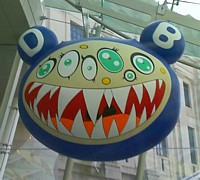
Takashi Murakami, DOB’s March, 1995 © Takashi Murakami/Kaikai Kiki Co., Ltd.
All Rights Reserved
Or, if they have passed on, would have hated it. The list is composed largely of those who despised Pop Art the first time around — mostly because of an emotional, poetic, and/or economic stake in Abstract Expressionism. The fear was that Pop would replace the well-worn, familiar feeding-trough, the A.E. hierarchy, and hard-won standards of seriousness — and machismo. At the same time, Minimalism, neither friend nor foe of Pop, was another threat that needed to be squashed. How could you have art without obvious self-expression? Without the traces of the artist’s hand?
Long Live Pop
I will not share my list with you, because some Anti-Popsters are still alive, if not exactly alive and kicking. You can come up with your own. Suffice it to say, I myself was prepared to hate Murakami’s slick and oddly sticky offerings. How dare this artist appropriate manga and anime — two well-known Japanese mass-media forms — with such cynicism, such determination both to shock and please? How dare he, like a certain mastermind of marketing, place some of his paintings on top of his own wallpaper?
I hated Murakami’s Reversed Double Helix (2003) when it was shown at Rockefeller Center a few years ago. It seemed gaudy and small. There was no way it could reach the grandeur of Jeff Koons’ miraculous flower puppy.
But I hope I am not giving too much away right here at the start. I’ll begin by saying that I was greeted by a Reversed Double Helix doppelganger called Tongari-kun (Mr. Pointy) smack in the middle of the BMA’s silly glass entrance. I’ve said it before and I will say it again (art critics never forget, never forgive): when is the next hydrofoil ferry leaving? And for this they ruined the grand stepped entrance?
Although the sculpture was iffy, the floating DOB’s March balloon at least has some teeth to it. The cute but snarling DOB figure is said to be the artist’s surrogate. On the way in, I was already warming to the forthcoming charming but disarming stew.
But not quite yet.

The exhibition begins in the fifth-floor rotunda. I breezed by some Murakami paintings that did not at first impress and took a quick look at the ultra-cute Miss ko2 (1997), a painted fiberglass statue of a perky, fetishized waitress. My exploration of anime (rented from Kim’s Video on St. Mark’s) of over a decade ago had clued me in to the salaryman’s schoolgirls-in-uniforms fetish. Cute nurses-in-uniforms also figure in anime soft-core. So I guess I need to add cute and perky waitresses-in-uniforms to my useless list.
Smack in the middle of the rotunda was Murakami’s three-part Second Mission Project ko2 Advanced (1999-2007). Miss Cute Waitress, in three steps — Human Type, GA-Walk Type, and, yes, Jet Airplane Type — is transformed into a scary, deadly, no longer cute jet airplane. Well, that bears thinking about. Nevertheless, my first response was that I had already seen such things in the second-floor Japanese toy store a block from where I live: transformers are now universal, right? But what does it mean to transform a cute and perky waitress into a jet airplane? That stopped me in my tracks. I’m still not sure.
Takashi Murakami
Installation view of Miss ko2 (Project ko2) (1997)
at Wonder Festival, Summer 2000
Oil, acrylic, fiberglass, and iron
100 x 46 x 36 in.
Courtesy of Marianne Boesky Gallery, New York
Blum & Poe, Los Angeles, Galerie Emmanuel
Perrotin, Paris and Miami, and Tomio Koyama Gallery Tokyo
Photo by Kazuo Fukunaga
©1997 Takashi Murakami/Kaikai Kiki Co., Ltd. All Rights Reserved
I have been to Japan a number of times on various projects — as the U.S. commissioner for an international survey of figurative painting, to write a text about a contemporary ceramics artist, and once to attend a glass-art conference in the little city of Seto. I should also point out that I live in a colonized East Village. There are so many Asian students at nearby NYU that the area could be called Little Tokyo. Strange fast-food chains with names like Very Berry and T-Kettle are dotted along St. Mark’s Place, no doubt soon to edge out tattoo parlors and other tidewrack.
Bubble tea is not my favorite thing in the world, nor is any of the Japanese pastry, which has more eye-appeal than taste. But I shop routinely in the totally Japanese, Stuyvesant Place Sunrise Mart above the St. Mark’s Bookshop on The Bowery. I also seek out the latest secret ramen joint, occasionally have exquisite sushi at Hasaki on 9th Street, and will happily slurp cold noodles or hot udon at Soba-ya, also on 9th.

Promo for rapper Kanye West, designed by Murakmi (not in exhibition)
Cuteness-hating, salaryman-hating, good old me, I wandered into the Murakami films, which are being shown in a dark room just off the rotunda. The first one up was a music video for rap star Kanye West’s Good Morning, called not surprisingly Good Morning. A cuddly-cute bear wearing cute shades barrels through a number of cute and not-so-cute ultra-urban encounters.
Wait a minute. Those are my sunglasses, white ones with slats instead of glass. The cute teddy bear is wearing my new glasses. I bought them at a sidewalk stand on St. Mark’s and Second Avenue in front of Gem Spa just a month ago, but after a great deal of debate. Would I actually wear them to the beach this summer? Would they protect my eyes? I think not, said the Indian man stationed at the outdoor sunglass rack. They are for parties. And what color should I get? I looked at orange and Day-Glo green, but settled on stark white as much more becoming. They were only $5. Alas, upon minute inspections mine are slightly different from those in Murakami’s music video. Mine were designed in Italy and “hand-polished in China.” Nevertheless, I will keep them forever, even if I do not wear them to Ho-Hum beach.
You can see Murakami’s “hip-hop” music video on (click here) Myspace and I am sure you will agree that although I may now fear I will look like a cute anime teddy bear, my nearly identical sunglasses must be extremely cool.
Next on the bill were two episodes of Murakami’s Kaikai & Kiki (2007). Bunny-cute Kaikai has protrusions on his/her head that could be mistaken for bunny-cute ears. Kooky-cute Kiki has three and sometimes five cute-Keane anime-type eyes.
When I was back in the East Village, I decided I needed to look at some anime again: not Akira or cute perky-breasted porn featuring cute nurses nursing (each other), but Sailor Moon (barf!) and Demon Beast Invasion (surprisingly lewd and violent). You see, in terms of the latter, muscular demon giants on steroids once ruled the earth and had to leave when the atmosphere changed and now they are back trying to impregnate cute human girly-girls so their demon offspring will be born acclimatized…The big demon seems to have not-cute tubes coming out of his not-cute nipples and other places that he uses to… Well, never mind. Until he meets the cute heroine who can’t get enough of those demon tentacles, his stock response to his own failure to implant his demon seed is: “Another inadequate earth girl.” Earth girl dead, bloody dead, gruesomely unpregnant and dead.
What happened to cute? Did I miss something?
Demon Beast Invasion did have an extra that tried to explain some anime conventions to the uninformed. Yes, Japanese men have a schoolgirl fetish. The weird hairdos are so we can easily differentiate all the cute and perky, squeaky-voiced teenage girls. The big eyes? They come from Betty Boop, which was an early cartoon import from the U.S., and not from Margaret Keane’s bug-eyed children.
Long Live Poop
Oddly enough, Episode I of Murakami’s Kaikai & Kiki is called “Planting the Seeds.” No, not those kind of seeds, not demon seeds, watermelon seeds. It is really all about poop.
Poop Alert! Poop Alert! Click here for a preview.
The seeds need poop to pop. The sophisticated audience giggles on cue every time the word poop is used. When the seeds refuse to pop up, Kaikai provides some human fertilizer. Very educational.
Infantilism! It’s as if that other favorite of mine — the cunningly cute, British-born Teletubbies — somehow got crossed with some coprophilic Japanese daydream. Episode II features even more poop. I’ve heard that body functions are treated cavalierly in Japan, but not pubic hair, as I myself found out when a Philip Pearlstein painting for the exhibition I was curating for a Japanese department store was stopped by Japanese customs. Or is Murakami just being naughty? Will we ever see episodes of Kaikai & Kiki on PBS?
Next we are treated to the “preview trailer” for Murakami’s first live-action feature, to be called Dharma. The film, which so far looks very, very chic indeed, will feature an impotent assassin who meets his doppelganger in Tokyo.
The films – and I am being serious — set the right tone for the exhibition, and I recommend that you see them first. Don’t even look at Miss ko2 until you’ve seen the films.

I am not sure if it is the exhibition layout over two floors — in and out of rotundas and some odd side rooms, here and there, and even down a staircase, papered with Murakami wallpaper — that is non-linear, or the oeuvre itself. The highly publicized Louis Vuitton boutique featuring Murakami’s not very original handbags is dead center. The staff is immaculately white-suited. That’s the most interesting thing about the embedded boutique, certainly not the handbags. And then there’s a cheaper gift shop with Kaikai & Kiki souvenirs and $100 stuffed toys, all more to my liking than the logo-speckled bags. But I don’t remember seeing my white, slated sunglasses. That is a retailing mistake.
The exhibition feels immense, but to me — at least the first time around — there were two highlights. I count the two statues called Hiropon and My Lonesome Cowboy as one piece, at least the way they are here installed, facing each other, in a room “decorated” with “cream” splashes.
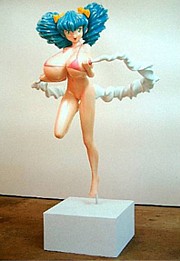 I was amused to see the mom of a well-heeled mom-and-pop team trying to explain to her seven-year-old daughter (and with a straight face, while daddy shrank to nothingness nearby) why the young lady with the enormous breasts was squeezing her cute cherrylike nipples to spurt a cute circle of milk that was like a dairy hula-hoop. While poised on one foot.
I was amused to see the mom of a well-heeled mom-and-pop team trying to explain to her seven-year-old daughter (and with a straight face, while daddy shrank to nothingness nearby) why the young lady with the enormous breasts was squeezing her cute cherrylike nipples to spurt a cute circle of milk that was like a dairy hula-hoop. While poised on one foot.
If you can’t explain Hiropon to your seven-year-old, then you probably can’t explain her companion, My Favorite Cowboy, who is spurting a rope or whip of “cream” from his erect, hand-held penis. Leave your seven-year-old at home.
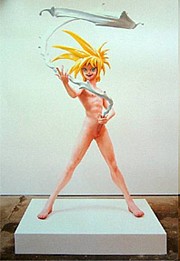 You can hear the artist himself trying to explain his My Lonesome Cowboy by dialing 718-362-9589, followed by 10#. This is the BMA’s cellphone gallery guide, which can be called from anywhere. Here you will learn that Murakami has never seen the film Lonesome Cowboys. Guess who made that film?
You can hear the artist himself trying to explain his My Lonesome Cowboy by dialing 718-362-9589, followed by 10#. This is the BMA’s cellphone gallery guide, which can be called from anywhere. Here you will learn that Murakami has never seen the film Lonesome Cowboys. Guess who made that film?
My second highlight is Tan Tan Bo Puking (718-362-9589, 21# for Murakami’s explanation). Made in 2001, it is a large painting about…puking. Like pooping, everybody does it, but Murakami blows it up to Peter Saul proportions: throwing-up on acid, I suppose. But without disgust.
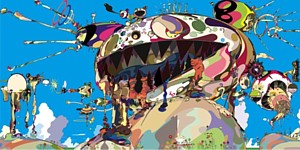 Takashi Murakami
Takashi Murakami
Tan Tan Bo Puking – a.k.a. Gero Tan, 2002
Acrylic on canvas mounted on board
141 3/4 x 283 7/16 x 2 5/8 in.
Collection of Amalia Dayan and Adam Lindemann
Courtesy of Galerie Emmanuel Perrotin, Paris and Miami
©2002 Takashi Murakami/Kaikai Kiki Co., Ltd. All Rights Reserved
If you want more of Murakami’s “explanations” or the sound is just not good enough on your cellphone click here for MoCA’s artist tour. MoCA is where the exhibition originated.
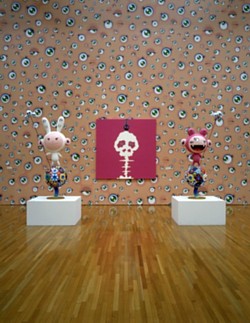
Murakami: Summon Monsters? Open the door? Heal? or Die? and Kaikai and Kiki
©2001 Takashi Murakami/Kaikai Kiki Co., Ltd. All Rights Reserved
And then there are the cute “flowers” and the very Miro/Kandinsky-cute “jellyfish.” Even the “death’s head” A-bomb blasts are radioactive cute. In writing about Murakami, nearly everything has to be put inside quotation marks. Even “Murakami” has to be put in quotes marks, for he has a huge staff. He is a huge staff. The crawl for one of his films goes on and on for an eternity.
And throughout the survey there are countless cross-references.
The early mushroom death’s head cloud (both on canvas and on wallpaper) rimes with the saccharin toadstools that come later. Somewhere well into the exhibition you will come across the Inochi cycle (c.2004). Inochi is a kind of hydrocephalic space alien. One loony theory is that the real aliens look like this because the oversize head will remind us of infants with their big heads, and thus we will go all warm and protective. But there is a Inochi on a flat screen in what appears to be a TV ad promoting milk as a healthy beverage. Did the Hiropon and Cowboy manikins start out as proposals for a national drink-milk ad?

Here are some generalizations:
1. Pop did not go away. It was only in hiding. Since art history is most productively seen as a braid with several strands, it is obvious that Koons first and now Murakami have ended the Pop occultation. Murakami has appropriated image types and even themes from Japanese popular culture and used them to create a weird, off-center language to address fecundity, mortality, infantilism, and, yes, commerce.
2. Although one way to make new art is to apply old principles to new materials and thus generate new images and new thoughts, I still wonder if Murakami’s obvious success is due to exoticism more than innovation. We have already seen artists appropriate comic-strip and cartoon material from Western mass media. Is referencing Japanese mass-media imagery a big step forward or only a shuffle sideways? Does it matter?
3. In the days when the only “mouse” other than the trappable kind was Mickey, I am told that pornographic versions of Walt Disney offerings and Looney Tunes escapades were made sub rosa. And lewd Dagwood and Blondie comic books. But would paintings or videos of Minnie and Mickey pooping and puking instead of doing the old in-and-out be as effective as Murakami’s Nippon-centric efforts?
4. In terms of Japanese culture, one is initially attracted to the austerity of the tea ceremony, sumi ink drawings, Zen rock gardens, or the dry tearjerkers of Ozu, which, for all their focus on the quotidian, are in their own way as mysterious as any koan. They are so ordinary that they’re almost not there, even while you are watching them. And yet we are forced to care about a daughter growing up or some other banal family crisis. But in Japan there is a gaudy, bawdy shadow that balances restraint. Think of all that neon putting Times Square to shame. I can see how austerity can become oppressive, and one might be driven to seek excess to keep sane. Extreme decorum needs to be balance by extreme décor. Murakami represents that excess.
On my way out — obviously brainwashed by too many flowers, too many Betty Boop eyeballs, too many mushrooms, too many jellyfish, too many colors — the Mr. Pointy sculpture at the entrance now made perfect sense. Psychedelic Buddha? Why not. But shouldn’t he be pooping and puking?
Footnote: For samples of manga comics in English click here. The titles of these comics are in themselves poetic: Bleach, One Piece, School Rumble, Vampire Knight Air Gear, Eyeshield 21, Full Metal Alchemist, Bitter Virgin….There are highly segmented manga categories: boys, girls, of course, but also salaryman, “ladies” and, yes, adult (meaning porn). No porn here, sorry, but most you usually have to read them back to front and from right to left. There’s a diagram on the site to help you out. There are also on-line manga shrines devoted to particular comic books, but you will have to search for them yourself.
If you want a taste of anime, click here. The site is a little bit difficult to figure out and full of pop-ups and ads, but if you can find them, I recommend a 23 minute episode of the sugary Bleach (an anime version of the comic book) with English subtiles and the pro-peace Soul Eater.
FOR AN AUTOMATIC ARTOPIA ALERT FOR NEW ENTRIES
CONTACT: perreault@aol.com


